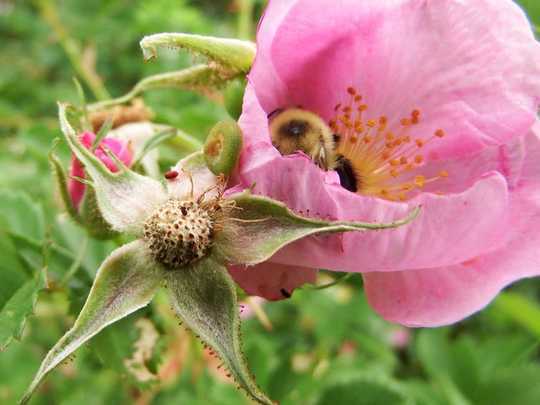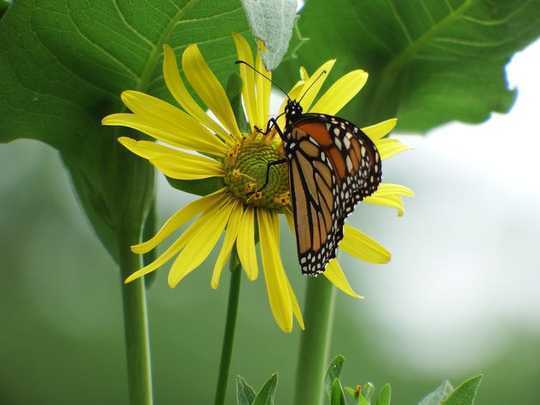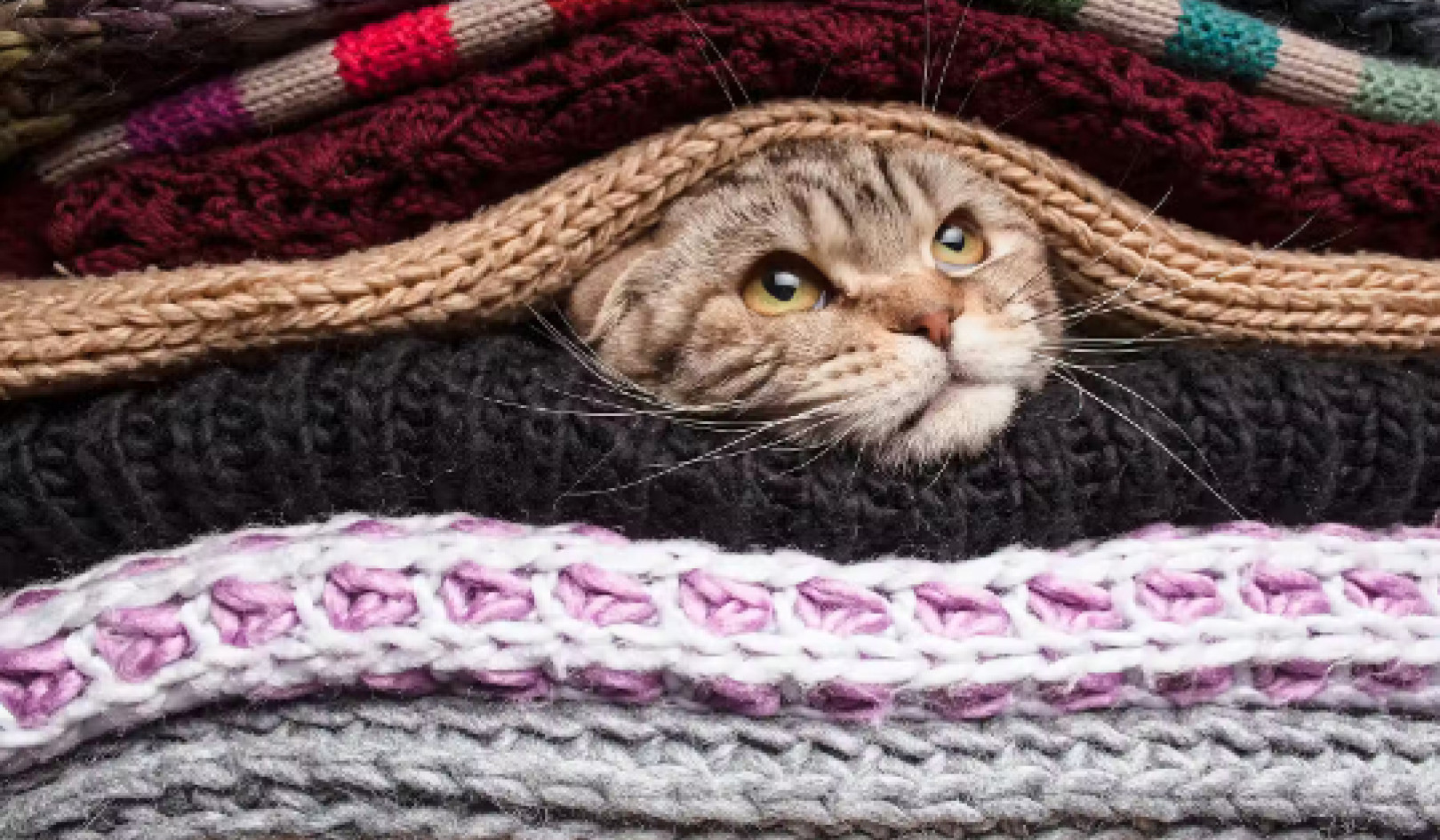 A giant swallowtail butterfly feeds from the flower of an alternate-leaved dogwood. (Nina Zitani), Author provided
A giant swallowtail butterfly feeds from the flower of an alternate-leaved dogwood. (Nina Zitani), Author provided
People across North America love to garden, yet the vast majority of garden plants are non-native species.
Day-lilies, peonies, roses, chrysanthemums and butterfly bushes, just to name a few, are all non-natives. They evolved in far-away places such as Europe and Asia and people transported them to North America.
With Insectageddon — the great insect die-off — upon us, it’s time to rethink our gardens.
Habitat destruction is the primary cause of the decline in biodiversity. Around the world, wildlife habitat has been destroyed by a variety of human activities such as residential and commercial development, agriculture and mining operations.
But gardeners can help to reverse the trend in biodiversity loss by creating backyard habitat, and native plants are the key.
Gardening with native plants has a long history in North America, but it remains under the radar of mainstream gardening. It’s time we embraced our native plants and the biodiversity that comes with them.
Our feathered — and furry — friends will thank us for it.
And if you’re an insect hater, now might be a good time to rethink that attitude.
Many insects are picky eaters
It was hot and steamy in the Costa Rican tropical forest. I was looking for caterpillars — the cute, wiggly, multi-legged and often furry larval stages of moths and butterflies.
As a graduate student at the University of Wyoming, I wasn’t studying caterpillars per se, but looking for new insect species. My job was to search for parasitoid wasps — minute, non-stinging wasps that spend their immature stage living inside caterpillars.
I collected the caterpillars in plastic bags along with the fresh green leaves they were feeding on, and brought them back to the field station for rearing.
But before I knew it, I was headed back into the forest. The caterpillars were leaf-eating machines and needed fresh leaves often. But I couldn’t just go into the forest and grab some leaves. I had to find the exact plant species the caterpillars were eating, or they would starve and die.
And that’s how I learned that caterpillars, most of them anyway, are picky eaters.
 The caterpillar of the giant swallowtail butterfly feeds on the leaves of hoptree. (Nina Zitani), Author provided
The caterpillar of the giant swallowtail butterfly feeds on the leaves of hoptree. (Nina Zitani), Author provided
Neatly tucked away in the scientific literature, you’ll find the fascinating story of plant-animal co-evolution that began millions of years ago during the Mesozoic Era. There are many outcomes of that co-evolution, such as pollination, seed dispersal and the close relationship caterpillars (and other plant-feeders) have with their food plants.
Today, flowering plants produce toxic chemicals in their leaves to deter animals from eating them. But some animals, namely caterpillars, have adapted to eat the plant leaves — toxins and all.
So if you’re interested in creating wildlife habitat in your backyard, then you’re going to need the favourite food plants of insects. Insects will then thrive in your garden — as will the many larger animals that depend on insects for food.
What is a native plant?
To better understand the concept of a native species, consider common milkweed and its relative, the dog-strangling vine.
Both are members of the milkweed family and found today in North America. Common milkweed is a native plant — it evolved in North America thousands of years ago, along with some other animals, including the monarch butterfly and the milkweed tussock moth. Today it is vital to the survival of those species.
But dog-strangling vine is a non-native plant from Europe that was introduced to North America by settlers in the 1800s. Monarch caterpillars and other native milkweed specialists that hatch on dog-strangling vine die because they can’t eat it.
 The caterpillar of a monarch butterfly on a milkweed plant. (Shutterstock)
The caterpillar of a monarch butterfly on a milkweed plant. (Shutterstock)
To make matters worse, dog-strangling vine has become an invasive species, forming dense colonies that displace native plants and their associated animals, contributing to biodiversity loss.
(No, it does not strangle dogs, by the way.)
Planting for the birds
Birds (and other larger animals) depend on bugs. “Nearly all terrestrial birds rear their young on insects, not seeds or berries,” writes Doug Tallamy in his book Bringing Nature Home.
A simple way to think of it is this: Native plants maintain natural ecosystem food webs, whereas non-native plants don’t. Native plants will attract and support healthy insect populations in your garden, which will provide essential food for birds and other animals.
There are thousands of native, or wild, North American pollinator species, including approximately 4,000 native bees and about 700 native butterflies, not to mention other pollinating insects such as moths, flies and beetles.
The leaves of native plants provide the food for caterpillars. The flowers of native plants provide food — pollen and nectar — for the pollinators.
When we consider the entire life cycle of insects, the essential role of native plants becomes clear.
 A caterpillar and a bumblebee on native Carolina rose. (Nina Zitani), Author provided
A caterpillar and a bumblebee on native Carolina rose. (Nina Zitani), Author provided
And let’s not forget the non-native honey bee, one of the few domesticated insect species. Although the honey bee is not wildlife, it does pollinate some crops and produces honey. It too will find plenty of food in a native plant garden.
Small gardens, big impact
My family kicked off our native garden by planting a single common milkweed plant into our tiny urban garden. The following summer it bloomed, and when a monarch butterfly landed on it, we were hooked.
When we moved to a larger property years later, we decided to create a monumental garden full of biodiversity.
We travelled for hours to purchase plants from nurseries that specialized in locally sourced native plants. Over several years, we planted more than 100 native species, including two kinds of milkweed, nannyberry, daisies of all sorts, multiple kinds of roses, dogwoods, elderberry and more.
We also planted hoptree (Ptelea trifoliata, a Citrus relative), the food plant for the caterpillar of the giant swallowtail, North America’s largest butterfly.
 A monarch butterfly gathers nectar on a native daisy commonly called cup plant. (Nina Zitani)
A monarch butterfly gathers nectar on a native daisy commonly called cup plant. (Nina Zitani)
You don’t need to have a huge garden to support wildlife. Start small, and plant just one native plant. Butterfly milkweed is a great choice, but there are thousands of native species to choose from. Starting small is better than not starting at all.
It’s easy to get started. The Nature Conservancy of Canada publishes the “Native Gardening 101” guide. The USDA Plants Database has species range maps for all of North America and allows you to search on common names of plants such as butterfly milkweed. The Ontario Invasive Plant Council’s “Grow Me Instead” guide includes many native plant options.
Nature Needs Half is a growing conservation movement. A reasonable end goal might be to devote half of your garden to native plants.
A year after we planted the hoptree, we spotted a giant swallowtail butterfly laying eggs on its leaves. Several days later we found the caterpillars eating the leaves, and we celebrated.
But not for long — we had gardening to do!![]()
About The Author
Nina M. Zitani, Assistant Professor of Biology, part-time, Western University
This article is republished from The Conversation under a Creative Commons license. Read the original article.
Related Books
at InnerSelf Market and Amazon
























